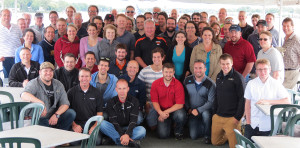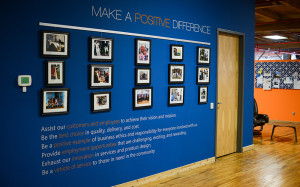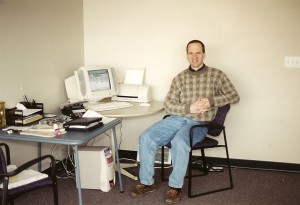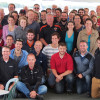 Disher is a very special company. It is 15 years old and 120 people strong. The workLIFEstory of its founder, Jeff Disher is really the story of the organization the entire team has built. I recently met with Jeff and Dayna Beal. Dayna is an original board member and now leads Discovery and Marketing. Together, Jeff and Dayna shared details about Disher’s approach to workLIFE, as well as history, stories, and lessons learned at this impressive company.
Disher is a very special company. It is 15 years old and 120 people strong. The workLIFEstory of its founder, Jeff Disher is really the story of the organization the entire team has built. I recently met with Jeff and Dayna Beal. Dayna is an original board member and now leads Discovery and Marketing. Together, Jeff and Dayna shared details about Disher’s approach to workLIFE, as well as history, stories, and lessons learned at this impressive company.
The company’s mission is to ‘make a positive difference’. By this they mean that their work should have meaning and make a lasting difference for the world. In Bring Work to Life, I talk about the need to create abundance in work-life. I see this as both an individual and an organizational responsibility. From an organizational perspective, Disher sets the bar in terms of how they are creating fulfillment for their employees and their customers. Wow. Let us count the ways:
Be Clear – Disher has brilliantly communicated their mission, their process, their values (they call them cultural characteristics), their history, and their inspiration for the future. Through graphics on the walls [photos to be inserted here], through photos posted throughout their space, through regular staff meetings with employees, and through their actions, they have been reinforcing their messages. Jeff believes that constant communication is the key. “If you’re not tired of hearing yourself talk about it,” he says, “then you’re not talking about it enough.” Aligning the organization and motivating mutual action takes communication that is constant and consistent.
Create Abundance – Abundance is the opposite of scarcity, of course. And providing lots of recognition is a way to create abundance and foster a culture of plenty. Disher account owners get emails – lots of emails – from satisfied customers extolling the virtues of staff members. And Disher pays attention. Every Friday, the leadership team gets together and goes through the recognition the Disher organization has received from customers and that they give to each other. Then, at a company-wide (free!) lunch, they meet with the staff to highlight all the great work of the week.
Create Inspiration and Identity – Disher has created a ‘Ripples of Influence map’ to show where their work began, where it is, and where they are going. These are the ripples of influence they’ve had from their inception until now and in the future. In addition, Disher includes a photo and a bio of every single team member on their website. Each and every person matters and is connected to the organization as a whole.
Be Open and Accountable. – Jeff says that all politics is really just hidden agendas. When we lay these bare and foster open communication, politics goes away. Gossip is Jeff’s pet peeve and there is no room for it at Disher. An important part of creating a positive environment is encouraging people to talk to each other openly. If they have an issue, they should resolve it with the other person. If they appreciate something someone has done, they should say so. This sharing, open, caring environment helps create a positive culture.
Fix Mistakes – In Bring Work to Life, I make the point that real learning or progress cannot occur without the opportunity to be vulnerable. Jeff agrees that people need to feel free to share weaknesses so that team members can help each other and support each other. Dayna relayed a story of an employee who recently sent an email to his team. He was apologizing for his behavior in a meeting where he hadn’t been at his best. He described the reason for his actions and asked for the team’s understanding and forgiveness. Team members rallied around him and supported him through the difficulty. Jeff also says that a lot of good culture is just good common sense – things we learned in kindergarten. Take mistakes. They require three aspects of response:
• Apologize and take responsibility
• Make it right
• Give the customer a reason to re-engage
“It’s not rocket science,” Jeff says. Most good leadership isn’t. It’s just doing the right thing.
Set Boundaries – How did Jeff manage the boundaries and ensure time for his own family, especially during the early, consuming days of the business? He protected weekends. Having weekend time with his family kept him sane and helped him rejuvenate. He would work late on Thursdays to ensure that he could get everything done prior to Saturday and Sunday. He let his wife and four children know not to expect him on Thursdays for dinner – but this gave him weekends and other weeknights to spend with the family.
Take a Risk and Follow Your Dream – Jeff left a great job because he wanted to try his hand at his own business. He was engaging with firms as vendors and realized that he could ‘make the meal instead of simply buying pre-packaged groceries’ – by creating his own business based on what he had learned in the customer’s shoes. It was risky but he believes, “you’re tested at the extremes of life. When you’re backed up against a wall, do you have what it will take?” He relishes the photo of his first day on the job sitting at a card table in a wobbly office chair. For him, the greater risk than starting the business, was not starting it, and regretting it. 
Contribute to the Community – The Disher team regularly does community activities. They believe in thriving together and doing this helps them grow together, achieve fulfillment, and ultimately serve employees and customers better. Whether it’s a Habitat for Humanity build or a puzzle tournament to benefit the Center for Women in Transition, it’s about reaching out and making a positive difference.
Cultivate the Garden – Jeff compares the organization to a garden. It takes constant work. You have to plant, prune, fertilize, and harvest. In addition, you must continue to invest time and energy or weeds will grow up. And fellow gardeners matter a lot. When hiring, their talent attraction team always seeks a culture match. People must have a can-do attitude and they must also have capability. Either one without the other won’t be a match. When getting to know someone as a potential employee, the leadership team (most of which have been on staff for over 10 years) considers whether they would want to travel with that person, go to a softball game with them, or share life with them – since after all, our work is a big part of life. These are significant questions that point to whether there is a fit between the candidate and the Disher culture.
Create Policies for the Responsible People – Disher has a relatively small number of policies. There is no vacation policy, for example. People are encouraged to take 2-3 weeks of vacation per year and to make good decisions about how much time off they take. People track their time for projects, but are encouraged to work a flexible schedule if it serves them and the team. Jeff shares the example of a petty cash system: If there’s a petty cash box and money is discovered to be missing, one option is to lock the box. But that only penalizes the 9 people who were honest based on the 10th person’s lack of integrity. Better than locking the box is confronting the issue directly and constructively and dealing with the problem. This approach builds a culture of personal responsibility, rather than heavy reliance on rules and regulations.
Seek Treetop Time – At Disher, ‘treetop time’ is encouraged in which there is the opportunity to plan, get away, and reflect on priorities for the future. This is important time both personally and organizationally. The employees are also encouraged to take casual time away with each other. They go out for ice cream together or they participate together in a pinewood derby. This personal interaction helps them build relationships where work and life intersect.
We know from research that purpose is one of the most critical elements for employee engagement and organizational success. Disher is surely doing purpose right. They are helping people see a big picture – making a positive difference and they are helping people see how they matter to the work and to the organization’s success. And they are making human connections – which is the most important part of purpose.
We crave for our contributions to connect us with others around us – and to have ripples of influence to others and the world. We crave to thrive together and at Disher there’s a lot of that going on!
Would you like to tell your story? If so, let me know by emailing me at tbrower108@gmail.com. Why? One of the foundations of Bringing Work to Life is abundance: the idea that it is possible to find fulfillment, have it all, and avoid the trade-offs between work and life. After all, work and life aren’t separate things to be placed in containers, but part of an integrated whole of a satisfying life. Another foundation of Bringing Work to Life is the idea of multiple right answers. As we’re all seeking ways to bring work to life – and bring life to work – we can learn from each other’s unique solutions and stories. I’d love to learn about your story!
Tracy Brower is the author of Bring Work to Life by Bringing Life to Work: A Guide for Leaders and Organizations.
